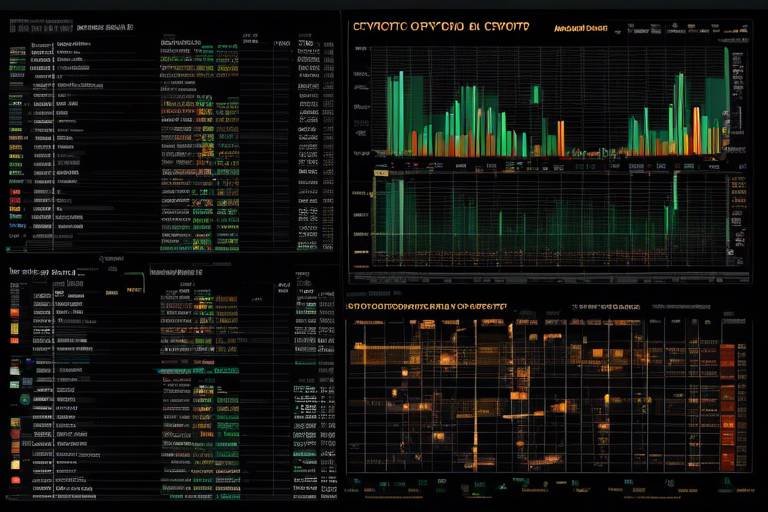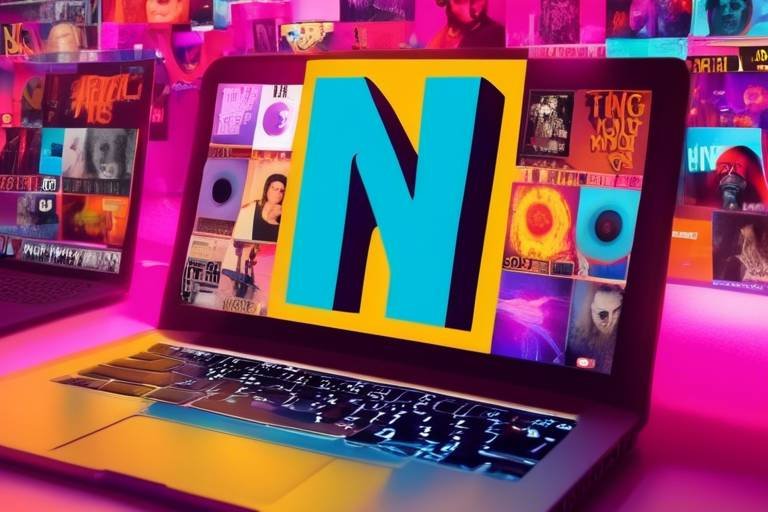The Intersection of Crypto and Augmented Reality
The digital landscape is evolving at an unprecedented pace, and at the heart of this transformation lies the fascinating convergence of cryptocurrency and augmented reality (AR). Imagine a world where your virtual assets have real-world value, where digital currencies can be seamlessly integrated into immersive experiences that blend the physical and digital realms. This intersection is not just a futuristic dream; it’s a burgeoning reality that is reshaping industries and redefining user interactions. As we delve deeper into this topic, we'll uncover how these two innovative technologies are not only enhancing user experiences but also paving the way for new economic models and opportunities.
Cryptocurrency has come a long way since the inception of Bitcoin in 2009. Initially viewed with skepticism, it has now emerged as a formidable player in the digital economy. The market dynamics of cryptocurrency are complex, characterized by volatility, speculation, and rapid technological advancements. Today, cryptocurrencies are not just a means of exchange; they represent a revolutionary shift in how we perceive value and conduct transactions. With the rise of decentralized finance (DeFi) and blockchain technology, cryptocurrencies have opened the door for innovative applications, including the integration with augmented reality.
Augmented reality is a technology that overlays digital information onto the physical world, enhancing our perception and interaction with our surroundings. Think of it as a bridge between the tangible and the virtual, where digital elements enrich our experiences in real-time. This technology relies on various components, including computer vision, simultaneous localization and mapping (SLAM), and depth tracking. By fusing these elements, AR creates immersive environments that captivate users and provide them with interactive experiences. As we explore the implications of AR, it becomes clear that its potential is magnified when combined with the economic capabilities of cryptocurrency.
One of the most exciting areas where the integration of cryptocurrency and augmented reality is making waves is in the gaming industry. Imagine a game where players can earn cryptocurrency by completing quests, participating in battles, or trading virtual assets. This integration not only transforms player engagement but also introduces new economic models within virtual spaces. Players can now engage in real-world transactions, blurring the lines between gaming and financial investment. The potential for in-game economies is vast, allowing players to earn, trade, and spend cryptocurrencies seamlessly.
In-game economies are evolving rapidly as players seek to monetize their gaming experiences. With cryptocurrencies, players can engage in transactions that have real-world implications. For instance, a player might earn a specific cryptocurrency by completing challenges, which they can then trade for other digital assets or even cash out in the real world. This creates a vibrant ecosystem where entertainment and financial investment coexist, offering players the opportunity to not only enjoy their favorite games but also build wealth.
Non-fungible tokens (NFTs) have emerged as a game-changer in the realm of augmented reality gaming. These unique digital assets allow players to own and trade items that are verifiably scarce and distinct. Imagine owning a rare sword in a fantasy game that no one else can replicate. With AR, players can visualize these assets in their physical space, enhancing the sense of ownership. The security of blockchain technology ensures that these transactions are transparent and trustworthy, allowing players to trade their NFTs with confidence.
Beyond gaming, the fusion of cryptocurrency and augmented reality is poised to revolutionize various sectors, including retail, real estate, and education. In retail, customers can use AR to visualize products in their homes before making a purchase, while cryptocurrency facilitates secure transactions. In real estate, potential buyers can take virtual tours of properties and make offers instantly using cryptocurrency. Education can also benefit from AR by providing interactive learning experiences, where students can engage with digital content and make payments for courses using crypto.
At the core of both cryptocurrency and augmented reality lies blockchain technology, which ensures transparency, security, and trust in digital transactions. This decentralized ledger system records all transactions in a secure and immutable way, making it ideal for applications in both fields. The integration of blockchain in AR applications allows for secure interactions and transactions, fostering a new level of trust between users and platforms.
Smart contracts are self-executing contracts with the terms of the agreement directly written into code. In the context of AR applications, smart contracts can facilitate automated agreements and transactions without the need for intermediaries. This streamlining of processes enhances efficiency and reduces costs across various industries, making it easier for businesses to adopt these technologies.
The emergence of decentralized platforms that leverage both AR and cryptocurrency is fostering innovation and collaboration. These platforms minimize reliance on traditional systems, allowing for a more democratized approach to technology. By enabling creators and developers to build applications that integrate both technologies, we are witnessing a new wave of creativity and entrepreneurial spirit.
As we look to the future, the potential developments at the intersection of cryptocurrency and augmented reality are boundless. Emerging technologies, such as artificial intelligence and machine learning, will likely play a significant role in enhancing user experiences. Increased user adoption rates will further drive innovation, impacting global markets and creating new opportunities for businesses and consumers alike. So, buckle up; the journey into this exciting frontier is just beginning!
- What is the main benefit of combining cryptocurrency and augmented reality?
Combining these technologies enhances user experiences, creates new economic models, and allows for real-world transactions within virtual environments. - How can NFTs be used in augmented reality?
NFTs allow players to own unique digital assets that can be visualized in their physical space, enhancing the sense of ownership and enabling secure trading. - What role does blockchain play in this intersection?
Blockchain technology provides the necessary security, transparency, and trust for transactions and interactions in both cryptocurrency and augmented reality.

The Rise of Cryptocurrency
The journey of cryptocurrency is nothing short of remarkable. From its humble beginnings with Bitcoin in 2009, it has evolved into a multi-trillion-dollar industry that is reshaping the way we think about money, value, and transactions. The allure of digital currencies lies not only in their potential for high returns but also in their ability to operate outside traditional financial systems. This decentralization allows for greater accessibility, especially in regions where banking infrastructure is lacking.
As cryptocurrencies gained traction, they sparked a wave of innovation across various sectors. The market dynamics have been influenced by factors such as increased adoption by businesses, regulatory developments, and technological advancements. For instance, major companies like Tesla and PayPal have begun accepting cryptocurrencies, signaling a shift in mainstream acceptance. This shift has led to a surge in interest from both retail and institutional investors, creating a vibrant ecosystem that supports numerous altcoins and blockchain projects.
Moreover, the rise of cryptocurrency has paved the way for new technologies, including augmented reality (AR). The intersection of these two fields presents exciting possibilities for enhancing user experiences and creating new economic models. As we explore the convergence of crypto and AR, it’s essential to understand the fundamental aspects of cryptocurrency that have contributed to its meteoric rise:
- Decentralization: Cryptocurrencies operate on decentralized networks, which means they are not controlled by any single entity. This feature promotes transparency and reduces the risk of fraud.
- Security: Blockchain technology, the backbone of cryptocurrencies, offers a secure method of recording transactions, making it nearly impossible to alter past records.
- Global Reach: Cryptocurrencies can be sent and received anywhere in the world, eliminating the barriers posed by traditional banking systems.
- Innovation: The rise of decentralized finance (DeFi) and non-fungible tokens (NFTs) showcases how cryptocurrencies are driving innovation in finance and digital ownership.
To summarize, the rise of cryptocurrency is not just a trend; it represents a fundamental shift in how we perceive and interact with money. As the digital economy continues to grow, the potential for integrating cryptocurrency with emerging technologies like augmented reality becomes increasingly apparent. This convergence promises to create new opportunities for users and businesses alike, redefining the landscape of the digital world.

Understanding Augmented Reality
Augmented Reality (AR) is a fascinating technology that bridges the gap between the digital and physical worlds. Imagine walking through a park and seeing digital butterflies fluttering around you or trying on a pair of virtual sunglasses without stepping foot in a store. This is the magic of AR! It enhances our real-world experiences by overlaying digital information—like images, sounds, and even scents—onto our surroundings. The technology relies on various components, including hardware like smartphones and smart glasses, as well as software that processes and displays the virtual elements.
The foundation of AR rests on several technological advancements. At its core, AR utilizes computer vision, simultaneous localization and mapping (SLAM), and depth tracking to understand the environment and position digital content accurately. This creates an immersive experience, making users feel as if the virtual elements are part of their reality. With the advent of powerful smartphones and advanced graphics processing units (GPUs), AR has become more accessible and engaging than ever before. The applications of AR are vast, ranging from gaming and entertainment to education and healthcare.
One of the most exciting aspects of AR is its ability to transform user experiences across different sectors. For instance, in retail, AR can allow customers to visualize how furniture would look in their homes before making a purchase. In education, students can explore historical events or scientific phenomena in an interactive manner, enhancing their learning experience. The potential is limitless, and as AR technology continues to evolve, we can expect even more innovative applications to emerge.
Moreover, the integration of AR with other cutting-edge technologies, such as Artificial Intelligence (AI) and the Internet of Things (IoT), is paving the way for even more sophisticated experiences. For example, AI can analyze user behavior and preferences to provide personalized AR content, while IoT devices can trigger AR experiences based on real-time data. This synergy not only enriches user engagement but also opens up new avenues for businesses to connect with their customers.
In summary, understanding Augmented Reality is essential for grasping its potential impact on various industries. As we continue to explore the intersection of AR and other technologies, we are likely to witness a revolution in how we interact with the world around us. The combination of AR with cryptocurrency, as we will discuss later, could create even more exciting possibilities, merging virtual economies with our everyday lives.
- What devices can run Augmented Reality applications? Most modern smartphones, tablets, and smart glasses are equipped to run AR applications, thanks to their advanced cameras and sensors.
- Is Augmented Reality the same as Virtual Reality? No, AR overlays digital content onto the real world, while Virtual Reality (VR) immerses users in a completely virtual environment.
- Can Augmented Reality be used in education? Absolutely! AR can enhance learning by providing interactive and immersive experiences that make complex subjects more relatable.
- How does Augmented Reality work? AR works by using cameras and sensors to detect the environment, then overlaying digital content based on that information, which is displayed on a screen or through special glasses.

Applications in Gaming
As we dive into the exciting world of gaming, it’s impossible to ignore how the combination of cryptocurrency and augmented reality (AR) is revolutionizing the gaming landscape. Imagine a universe where your digital achievements translate into real-world value; that's the magic these technologies conjure. Players are no longer just participants in a game; they are active investors in a virtual economy that thrives on the principles of blockchain and AR.
One of the most thrilling aspects of this convergence is the way cryptocurrency enhances player engagement. In traditional gaming, players often invest countless hours and dollars into virtual worlds, but they rarely see any return on their investment. However, with the integration of cryptocurrency, players can earn digital currencies through gameplay, which can then be traded or spent in real-world markets. This creates a dynamic ecosystem where every achievement has tangible value.
Furthermore, augmented reality adds an immersive layer to this experience. Picture yourself wandering through your neighborhood, phone in hand, and suddenly, you stumble upon a rare virtual item hidden in your local park. By using AR technology, games can create these engaging experiences that blend the digital and physical worlds seamlessly. Players can interact with their surroundings in ways that were previously unimaginable, making every gaming session feel like an adventure.
In-game economies are rapidly evolving as well. Players can now earn, trade, and spend cryptocurrencies within the game itself, creating a vibrant marketplace where items and achievements have real-world value. Just like in traditional economies, players can make strategic decisions about when to buy, sell, or hold their assets, adding a layer of financial strategy to their gaming experience. This shift not only enhances player engagement but also fosters a sense of community as players collaborate and compete in this new economic landscape.
Another exciting development is the role of non-fungible tokens (NFTs) in augmented reality gaming. NFTs allow players to own unique digital assets, such as rare skins, weapons, or even virtual real estate. This ownership is secured on blockchain platforms, ensuring that players can trade their assets without fear of fraud. Imagine owning a one-of-a-kind sword in a fantasy game that you can sell for a significant profit or keep as a cherished trophy. This level of ownership transforms the gaming experience, making it more personal and rewarding.
As we look to the future, the synergy between cryptocurrency and augmented reality in gaming will only grow stronger. Developers are continually finding innovative ways to engage players, turning gaming into an experience that is not just about entertainment but also about financial empowerment. The possibilities are endless, and as technology continues to advance, we can expect even more exciting developments in this space.
- What is the primary advantage of using cryptocurrency in gaming? Cryptocurrency provides players with the opportunity to earn real-world value from their in-game achievements, creating a more rewarding experience.
- How do NFTs work in augmented reality games? NFTs are unique digital assets that players can own and trade, secured by blockchain technology, ensuring authenticity and ownership.
- Can augmented reality enhance the gaming experience? Yes, AR creates immersive environments that blend the digital and physical worlds, making gameplay more engaging and interactive.

In-Game Economies
Imagine diving into a virtual world where every action you take can lead to real-world financial rewards. Sounds exciting, right? Well, that’s exactly what the integration of cryptocurrency into augmented reality (AR) gaming is bringing to the table. In-game economies are evolving at lightning speed, creating vibrant ecosystems where players can earn, trade, and spend cryptocurrencies. This shift is not just a trend; it’s a transformation that is reshaping how we perceive gaming and its economic potential.
At the heart of these in-game economies lies a fascinating interplay between entertainment and investment. Players can now engage in activities that yield tangible benefits, such as earning tokens for completing quests or trading rare items on blockchain marketplaces. This gamification of finance not only enhances player engagement but also encourages a sense of ownership and investment in the game. In many ways, it’s like turning a casual hobby into a potential revenue stream.
Let’s break down how these in-game economies function. Typically, they operate on a decentralized model, where players engage in transactions using cryptocurrencies. Here’s a simple overview of how it works:
| Action | Outcome |
|---|---|
| Complete a Quest | Earn Cryptocurrency Tokens |
| Trade Items | Gain or Lose Tokens Based on Market Value |
| Participate in Events | Receive Unique Rewards and Tokens |
This table illustrates the dynamic nature of in-game economies. Players are not just passively participating; they are actively involved in a marketplace where their decisions impact their financial outcomes. The ability to trade items and earn tokens creates a thrilling sense of urgency and strategy. Players often find themselves strategizing not only for gameplay success but also for financial gain, making every decision critical.
Moreover, the concept of player ownership is revolutionizing the gaming landscape. With the advent of non-fungible tokens (NFTs), players can own unique digital assets that have real-world value. Imagine owning a rare sword or a special character skin that you can trade or sell outside of the game. This ownership fosters a deeper connection to the game and its community, as players can showcase their achievements and investments.
In essence, in-game economies are creating a new paradigm for gamers. They are no longer just players; they are investors, traders, and entrepreneurs. This shift is paving the way for a future where gaming and finance are intertwined, offering opportunities that extend beyond the screen. As augmented reality continues to evolve, the possibilities for in-game economies will only expand, leading to even more innovative ways for players to engage and profit from their gaming experiences.
- What are in-game economies? In-game economies refer to the virtual financial systems within games that allow players to earn, trade, and spend cryptocurrencies.
- How do cryptocurrencies work in gaming? Players can earn cryptocurrencies through gameplay, which can then be traded or used for in-game purchases, creating a real economic impact.
- What role do NFTs play in gaming? NFTs provide players with ownership of unique digital assets, allowing them to trade or sell these items outside the game.
- Are in-game economies secure? Yes, most in-game economies utilize blockchain technology, which provides transparency and security for transactions.

Player Ownership and NFTs
The modern gaming landscape is undergoing a radical transformation, thanks to the integration of non-fungible tokens (NFTs) within augmented reality (AR) experiences. Imagine a world where your in-game achievements are not just ephemeral trophies but tangible assets that you can truly own and trade. This is where NFTs come into play, enabling players to possess unique digital items that represent their accomplishments, skills, and creativity. With NFTs, the concept of ownership in gaming shifts from mere possession within a game to a verified, blockchain-backed claim that can be bought, sold, or traded across various platforms.
One of the most exciting aspects of NFTs in AR gaming is the ability to create a vibrant marketplace for digital assets. Players can acquire exclusive skins, weapons, or even virtual real estate that are represented as NFTs. These items are not just for show; they hold real value in the digital economy. For instance, a rare skin in a popular AR game could fetch thousands of dollars, depending on its rarity and demand. This new paradigm not only enhances player engagement but also fosters a sense of community as players trade and showcase their unique possessions.
Moreover, the use of NFTs ensures that players have true ownership rights over their digital assets. Unlike traditional gaming models where items can be taken away or become obsolete with updates, NFTs provide players with a permanent record of ownership. This is achieved through blockchain technology, which serves as a decentralized ledger that verifies the authenticity and ownership history of each item. As a result, players can feel secure in their investments, knowing that their assets cannot be duplicated or stolen.
However, the integration of NFTs in AR gaming isn't without its challenges. Issues such as environmental concerns related to blockchain energy consumption, as well as the need for user education about digital wallets and transactions, must be addressed. Nevertheless, the potential for player empowerment and the creation of new economic models within the gaming industry is immense. For example, players can participate in governance decisions regarding game development or even earn a share of profits through their contributions to the game ecosystem.
In conclusion, the confluence of player ownership and NFTs in augmented reality gaming not only enhances the gaming experience but also opens up new avenues for economic participation. As players embrace this new era of digital ownership, the gaming world is set to evolve into a more dynamic and interactive space, where every player's contribution is recognized and rewarded. The future of gaming is here, and it’s a thrilling ride into a world where your digital possessions hold real-world value.
- What are NFTs? NFTs, or non-fungible tokens, are unique digital assets verified using blockchain technology, allowing for true ownership of digital items.
- How do NFTs work in augmented reality games? In AR games, NFTs represent unique in-game items that players can buy, sell, or trade, providing real-world value and ownership.
- Can I lose my NFTs? As long as you secure your digital wallet and keep your private keys safe, your NFTs are secure and cannot be duplicated or taken away.
- Are NFTs environmentally friendly? The environmental impact of NFTs is a topic of debate, as some blockchain networks consume significant energy. However, many are exploring more sustainable alternatives.

Real-World Applications
The fusion of cryptocurrency and augmented reality (AR) is not just a futuristic concept; it's already reshaping various industries in profound ways. Imagine walking through a retail store where the products you see are enhanced with digital information, allowing you to pay for them using cryptocurrency without ever needing to pull out your wallet. This is just one of the many innovative applications that are emerging at the intersection of these two groundbreaking technologies.
In the retail sector, businesses are leveraging AR to create immersive shopping experiences. For instance, customers can use their smartphones to scan products and instantly receive detailed information, reviews, and even promotional offers displayed right in front of them. When integrated with cryptocurrency, this can lead to seamless transactions. Customers can make purchases using digital currencies, which can be faster and more secure than traditional payment methods. This not only enhances customer satisfaction but also streamlines the purchasing process.
In the realm of real estate, AR is transforming how properties are showcased. Potential buyers can take virtual tours of homes, experiencing them as if they were physically present. By incorporating cryptocurrency into this process, transactions can be simplified. For instance, a buyer can make an offer on a property using crypto, and smart contracts can facilitate the transaction without the need for intermediaries, ensuring a transparent and efficient process.
Education is another field ripe for the benefits of AR and cryptocurrency. Imagine students using AR to visualize complex scientific concepts, all while earning cryptocurrency through gamified learning experiences. This not only makes learning more engaging but also introduces students to the world of digital currencies, preparing them for a future where these technologies are commonplace.
Moreover, the integration of AR and crypto can lead to innovative marketing strategies. Brands can create AR experiences that encourage customer interaction, such as scavenger hunts where participants earn cryptocurrency rewards for finding virtual items. This not only boosts brand engagement but also creates a fun and rewarding experience for users.
To summarize, the real-world applications of combining cryptocurrency and augmented reality are vast and varied. From enhancing shopping experiences to revolutionizing real estate transactions and transforming education, the potential is enormous. As these technologies continue to evolve, we can expect even more groundbreaking applications that will reshape our interaction with the world around us.
- What is the main benefit of combining cryptocurrency with augmented reality?
The primary benefit is the enhancement of user experiences through seamless transactions and interactive environments, making processes quicker and more engaging. - How can businesses implement AR and cryptocurrency?
Businesses can start by integrating AR technologies into their marketing strategies and offering cryptocurrency payment options for products and services. - Are there any risks associated with using cryptocurrency in AR applications?
Yes, there are risks such as market volatility and security concerns, but with proper measures in place, these can be mitigated. - What industries will benefit the most from this integration?
Retail, real estate, education, and entertainment are among the industries that stand to gain significantly from the integration of AR and cryptocurrency.

Blockchain Technology's Role
Blockchain technology serves as the backbone for both cryptocurrency and augmented reality (AR), providing a robust framework that ensures transparency, security, and trust in digital transactions and interactions. Imagine a world where every transaction you make is recorded in a tamper-proof ledger, accessible to all but alterable by none. That’s the magic of blockchain! It creates an environment where users can engage freely and confidently, knowing their data and assets are secure.
The decentralized nature of blockchain eliminates the need for intermediaries, which often complicate and slow down transactions. Instead, it allows for peer-to-peer interactions, making processes faster and more efficient. For instance, when a user makes a purchase in an AR environment using cryptocurrency, the transaction is recorded instantly on the blockchain, ensuring that both the buyer and seller have a verifiable record of the exchange. This level of transparency not only fosters trust but also encourages more users to participate in the digital economy.
Moreover, blockchain technology enables the creation of smart contracts, which are self-executing contracts with the terms of the agreement directly written into code. These contracts automatically enforce and execute transactions when predetermined conditions are met, significantly reducing the need for manual oversight. This is particularly useful in AR applications, where users can engage in transactions without worrying about third-party involvement. For example, imagine a scenario in an AR-based real estate application where a smart contract automatically transfers ownership of a virtual property once the agreed-upon cryptocurrency is paid. This not only simplifies the process but also minimizes potential disputes.
Another vital aspect of blockchain's role is its ability to support decentralized platforms. These platforms leverage both AR and cryptocurrency to create innovative solutions that challenge traditional systems. By removing central authorities, users gain more control over their assets and data. This is particularly appealing in industries like gaming and retail, where user engagement is paramount. In a decentralized AR gaming platform, players can earn cryptocurrency while playing, trade their in-game assets securely, and even have a say in the game's development through decentralized governance.
In summary, blockchain technology is not just a supporting player but a fundamental component that enhances the synergy between cryptocurrency and augmented reality. It empowers users by providing a secure, transparent, and efficient environment for transactions, paving the way for novel applications across various industries. As we continue to explore this intersection, the potential for innovation seems limitless!
- What is blockchain technology?
Blockchain technology is a decentralized digital ledger that records transactions across many computers so that the recorded transactions cannot be altered retroactively.
- How does blockchain ensure security?
Blockchain uses cryptographic techniques to secure data and ensure that only authorized users can access or modify it, providing a high level of security against fraud and hacking.
- What are smart contracts?
Smart contracts are self-executing contracts with the terms written into code, allowing for automatic execution of transactions when conditions are met.
- How can blockchain enhance AR experiences?
Blockchain can enhance AR experiences by providing secure, transparent transactions, enabling digital ownership of assets, and facilitating decentralized platforms for user engagement.

Smart Contracts
When we talk about the fusion of augmented reality (AR) and cryptocurrency, we can't overlook the transformative power of . These self-executing contracts, with the terms of the agreement directly written into code, are revolutionizing how transactions occur in the digital realm. Imagine a world where agreements are executed automatically without the need for intermediaries—this is the essence of smart contracts. They not only streamline processes but also enhance security and transparency.
In the context of AR applications, smart contracts can automate a variety of functions. For instance, consider a real estate AR app that allows users to visualize properties in their actual locations. When a user decides to purchase a property, a smart contract can automatically handle the transaction, ensuring that funds are transferred only when all conditions are met, such as inspections and approvals. This eliminates the risk of fraud and miscommunication, making the buying process smoother and more reliable.
Moreover, the integration of smart contracts in AR can facilitate a range of interactions. For example, in AR gaming, players can engage in transactions involving in-game assets without worrying about payment disputes. The smart contract ensures that once a player agrees to buy an item, the transaction is executed seamlessly, and ownership is transferred instantly. This not only enhances user experience but also builds trust among players, fostering a more vibrant and engaged community.
To illustrate how smart contracts work in AR, let's look at a simplified example:
| Step | Description |
|---|---|
| 1 | User initiates a transaction in an AR application. |
| 2 | Smart contract verifies the conditions (e.g., funds available, item ownership). |
| 3 | Upon verification, the smart contract executes the transaction. |
| 4 | Ownership is transferred, and both parties receive confirmation. |
This level of automation not only saves time but also reduces costs associated with traditional transaction methods. As more industries begin to adopt AR and cryptocurrency, the role of smart contracts will likely expand, leading to innovative applications we haven't even imagined yet.
In conclusion, smart contracts are not just a technological novelty; they are a fundamental component of the evolving landscape where augmented reality and cryptocurrency meet. By automating transactions and ensuring compliance with agreed-upon terms, they pave the way for a more efficient and trustworthy digital economy.
- What is a smart contract? A smart contract is a self-executing contract with the terms of the agreement directly written into code, allowing for automated transactions without intermediaries.
- How do smart contracts enhance security? Smart contracts operate on blockchain technology, which ensures that all transactions are recorded transparently and cannot be altered, reducing the risk of fraud.
- Can smart contracts be used in any industry? Yes, smart contracts can be applied across various sectors, including real estate, gaming, finance, and supply chain management, enhancing efficiency and trust.

Decentralized Platforms
Decentralized platforms are revolutionizing the way we interact with technology, especially at the intersection of cryptocurrency and augmented reality (AR). Imagine a world where you don't have to rely on a single entity to control your digital experiences. Instead, you can engage with a network of users and developers who contribute to a shared ecosystem. This is the promise of decentralization, and it's gaining traction in both the crypto and AR spaces.
At its core, a decentralized platform operates on a peer-to-peer network, which means that no single party has complete control over the data or transactions. This model fosters transparency and trust among users, as every transaction is recorded on a public ledger known as the blockchain. In the context of AR, this means that users can interact with digital overlays in a secure environment, where their data and assets are protected from centralized authorities.
One of the most exciting aspects of decentralized platforms is their ability to create new economic models. For instance, developers can build AR applications that allow users to earn cryptocurrency by participating in various activities. This could range from creating content to engaging with advertisements in augmented reality environments. The potential for monetization is enormous, and it empowers users to take control of their digital interactions.
Moreover, decentralized platforms often incorporate smart contracts—self-executing contracts with the terms of the agreement directly written into code. These contracts automate processes and eliminate the need for intermediaries, streamlining operations across various industries. For example, in real estate, a decentralized AR platform could allow buyers and sellers to execute property transactions instantly, with all terms agreed upon and enforced by smart contracts.
To illustrate the impact of decentralized platforms, consider the following key features:
- Enhanced Security: By eliminating a central point of failure, decentralized platforms reduce the risk of hacking and data breaches.
- User Empowerment: Individuals have ownership over their data and digital assets, fostering a sense of community and collaboration.
- Innovation Catalyst: Developers are encouraged to create new applications and services, driving technological advancements.
In conclusion, the rise of decentralized platforms is paving the way for innovative applications that seamlessly blend cryptocurrency and augmented reality. As users become more aware of the benefits, we can expect to see a surge in adoption rates, leading to a more interconnected and user-driven digital landscape.
Q1: What are decentralized platforms?
A1: Decentralized platforms are systems that operate on a peer-to-peer network, allowing users to interact without a central authority controlling the data or transactions.
Q2: How do decentralized platforms benefit users?
A2: They provide enhanced security, user empowerment, and foster innovation, allowing users to have more control over their digital experiences.
Q3: What role do smart contracts play in decentralized platforms?
A3: Smart contracts automate agreements and transactions, reducing the need for intermediaries and streamlining processes across various industries.

Future Trends and Predictions
As we stand on the brink of a new technological revolution, the convergence of cryptocurrency and augmented reality (AR) is set to reshape our digital landscape in unimaginable ways. The future trends in this intersection promise not just innovation but also an evolution in how we interact with both digital and physical worlds. Imagine walking through your local mall and seeing virtual storefronts that accept cryptocurrency, or playing a game where your virtual assets have real-world value. The possibilities are as exciting as they are endless.
One of the most significant trends we can expect is the increased adoption of AR in everyday consumer experiences. Retailers are already experimenting with AR to enhance shopping experiences, allowing customers to visualize products in their own homes before making a purchase. This trend is likely to accelerate as more businesses recognize the potential of integrating crypto payments into these AR experiences. Imagine being able to use Bitcoin or Ethereum to buy that new couch you just placed in your living room through your smartphone!
Moreover, the rise of decentralized finance (DeFi) is expected to play a crucial role in this evolution. As AR applications become more sophisticated, they will likely incorporate DeFi mechanisms that allow users to earn interest on their crypto holdings while engaging with AR content. This integration could lead to a new wave of financial literacy among users, as they learn to navigate both the crypto and AR landscapes simultaneously.
Another exciting development on the horizon is the emergence of cross-platform compatibility. As both AR and crypto technologies evolve, we can anticipate a future where users can seamlessly transition between different platforms and applications. Imagine a scenario where you can use your AR headset to interact with a virtual world while simultaneously trading cryptocurrencies on a decentralized exchange. This integration will not only enhance user experience but also foster a more interconnected digital ecosystem.
Furthermore, as augmented reality becomes more mainstream, we will see an increase in user-generated content (UGC) within these digital environments. Users will create their own AR experiences, and the integration of cryptocurrency will allow them to monetize their creations. This could lead to a vibrant marketplace where artists, developers, and everyday users can sell unique AR experiences or digital assets, all powered by blockchain technology. Imagine a world where your creativity can directly translate into income!
To summarize, the future of the intersection between cryptocurrency and augmented reality is bright and filled with potential. As these technologies continue to evolve, we can expect:
- Increased adoption of AR in retail and everyday experiences.
- Integration of DeFi mechanisms within AR applications.
- Enhanced cross-platform compatibility for seamless user experiences.
- A vibrant marketplace for user-generated AR content and assets.
As we look ahead, it’s clear that the integration of these two powerful technologies will not only redefine how we interact with digital content but also create new economic opportunities. The digital economy is evolving, and those who adapt to these changes will be at the forefront of this exciting new era.
Q: How will cryptocurrency enhance augmented reality experiences?
A: Cryptocurrency will provide seamless payment options within AR applications, allowing users to make transactions effortlessly while interacting with digital content.
Q: What are the potential risks of combining AR and cryptocurrency?
A: As with any emerging technology, risks include security vulnerabilities, market volatility, and regulatory challenges that could impact user trust and adoption.
Q: Will user-generated content in AR be profitable?
A: Yes, as the marketplace for AR content grows, users will have opportunities to monetize their creations through cryptocurrency transactions.
Q: How can businesses benefit from integrating AR and cryptocurrency?
A: Businesses can enhance customer engagement, streamline transactions, and tap into new revenue streams by leveraging the combined power of AR and cryptocurrency.
Frequently Asked Questions
- What is the relationship between cryptocurrency and augmented reality?
Cryptocurrency and augmented reality (AR) are converging to create innovative experiences. Cryptocurrency offers a new way for transactions within AR environments, enabling real-world financial interactions in virtual spaces. This synergy enhances user engagement and creates new economic models, especially in gaming and digital assets.
- How is cryptocurrency changing the gaming industry?
In the gaming world, cryptocurrency is transforming player engagement by allowing real-world transactions and creating in-game economies. Players can earn, trade, and spend cryptocurrencies, leading to a blend of entertainment and financial investment. This shift not only enhances the gaming experience but also introduces players to the world of digital finance.
- What are NFTs and how do they relate to augmented reality?
Non-fungible tokens (NFTs) are unique digital assets that can represent ownership of virtual items in augmented reality games. They allow players to own and trade these assets securely on blockchain platforms. This ownership model empowers players and adds real-world value to their digital experiences.
- What practical applications exist for crypto and AR outside of gaming?
Beyond gaming, the combination of cryptocurrency and augmented reality has practical applications in various sectors such as retail, real estate, and education. For instance, AR can enhance customer interactions by overlaying digital information on physical products, while cryptocurrency facilitates seamless transactions, creating a more immersive shopping experience.
- How does blockchain technology support the integration of crypto and AR?
Blockchain technology serves as the backbone for both cryptocurrency and augmented reality by ensuring transparency, security, and trust in digital transactions. It allows for the creation of smart contracts, which automate agreements and transactions without intermediaries, streamlining processes across different industries.
- What are smart contracts and how are they used in AR applications?
Smart contracts are self-executing contracts with the terms of the agreement directly written into code. In augmented reality applications, they enable automated transactions and agreements, reducing the need for intermediaries. This technology can streamline various processes, making interactions more efficient and secure.
- What does the future hold for the intersection of crypto and augmented reality?
The future of cryptocurrency and augmented reality is promising, with potential developments including advancements in technology, increased user adoption, and significant impacts on global markets. As these technologies evolve, we can expect new applications and innovations that will reshape how we interact with both digital and physical worlds.



















